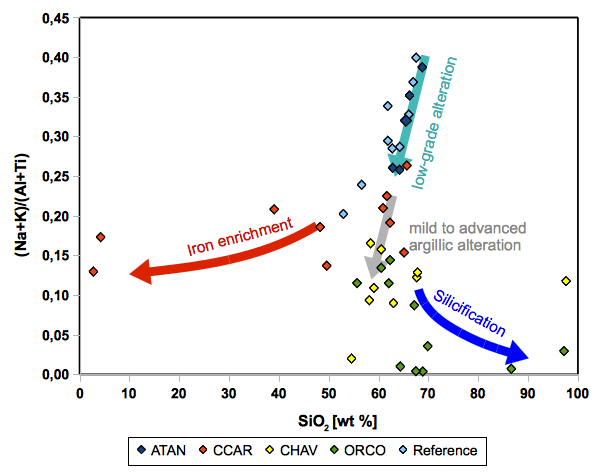
GeoPeP 2011/2012
Conclusion
This study provides information on different alteration types deduced from hydrothermal altered volcanic rocks. The investigated sites display a variable degree of (a) low-grade alteration associated with zeolithisized ignimbrites, (b) mild to advanced argillic alteration, (c) silicification and (d) Fe-hydroxide enrichment, depending on host-rocks, relative alteration temperatures in context with an underlying magma chamber, as well as fluid phase Eh-pH conditions and composition.

Fig.20: Diagram highlighting the different alteration Trends
Further investigations need to include clay mineral analysis aiming at obtaining information on exact clay mineral assemblages. To answer the question whether supergene or hypogene processes are dominant, S isotope analyses on alunite group minerals are required.
Acknowledgements
We thank Dr. Andreas Kronz and Magdalena Banaszak from the Electron Microprobe Laboratory, Dr. Klaus Simon from the ICPMS-Laboratory, Dr. Helmut Klein from the XRD-Laboratory and Dr. Gerald Hartmann from the XRF-Laboratory for their support. Furthermore, we thank Angelika Reitz and Erwin Schiffczyk for their help in preparing the samples. In addition, we would like to thank Melanie Brandmeier and Dr. Mirian Mamani for their general support. Special thanks go to Prof. Dr. Gerhard Wörner for the opportunity to work in the Andes, his ongoing availability for our questions, discussions and the numerous valuable suggestions. Financial support was provided by the DFG (Wo 362/43-1), the PROMOS-DAAD, Universitätsbund and GZG Göttingen.
© Christian Hansen, Andres Höweling, Kai Nitzsche, Tammo Ohlendorf 2012